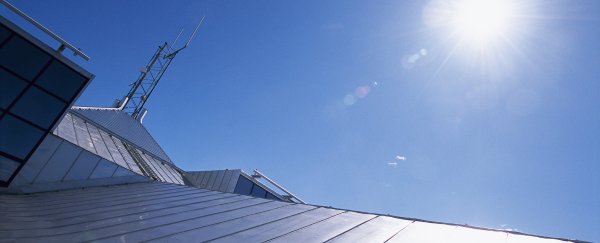Researchers from the Faculty of Science, University of Technology Sydney (UTS Science) have created a material that can stay cooler than the ambient air temperature, even in the height of Australian summer. And it could help to greatly reduce cooling costs and the environmental impact of air-conditioning.
The roofing material is made from stacked polymers on top of a thin silver film, and only absorbs an incredible 3 percent of sunlight. Impressively, it also radiates heat out at specific infrared wavelengths that aren't absorbed by the atmosphere - allowing it to beam the heat directly into space.
"We demonstrate for the first time how to make a roof colder than the air temperature around it, even under the most intense summer conditions," one of the lead researchers, Geoff Smith, told the press. "Roofs heat up by absorbing sunlight, so darker roofs can get very hot. Even white roofs still absorb enough sunlight to warm up by 9 degrees Celsius to 12 degrees Celsius."
Scientists have been working for years to create increasingly more heat-repellant materials to cover our houses with, but they've struggled to find anything that approaches 100 percent solar reflectance.
"This new surface, however, stayed 11 degrees or more colder than an existing state-of-the-art white roof nearby," Smith added.
 Infrared image of the new material (purple) on top of a regular white roof. Credit: UTS Science
Infrared image of the new material (purple) on top of a regular white roof. Credit: UTS Science
Even better, the materials used to create the demo-roof are already commercially available, and so far seem to be suited to creating basic roofing, which means they could easily be integrated by the construction industry.
The team has tested the roof on the top of the UTS Science building in Sydney, which is on a busy road and has no cover from the hot summer sun. Despite the conditions, they showed that the roof was able to stay significantly colder than the air around it, even in direct summer sunlight and when it became covered with traffic-produced dirt and grime. The results have been published open access in Advanced Science.
And while its energy-saving abilities overall haven't been tested as yet, Smith believes that it could substantially help to reduce the environmental costs of cooling.
"Cool roofing reduces the severity of the urban heat island problem in towns and cities and helps eliminate peak power demand problems from the operation of many air conditioners," he said. "The added feedback benefits from cool roofs are not yet widely appreciated, but recent reports have shown they are substantial. Examples include ventilation with cooler air and higher performance of rooftop air-conditioning installations."
We're pretty excited about a world where our homes are kept cool by their roofs, rather than electricity-guzzling air-conditioners. Someone get the technology commercialised, ASAP.
Love science? Find out more about the research happening at UTS Science.
